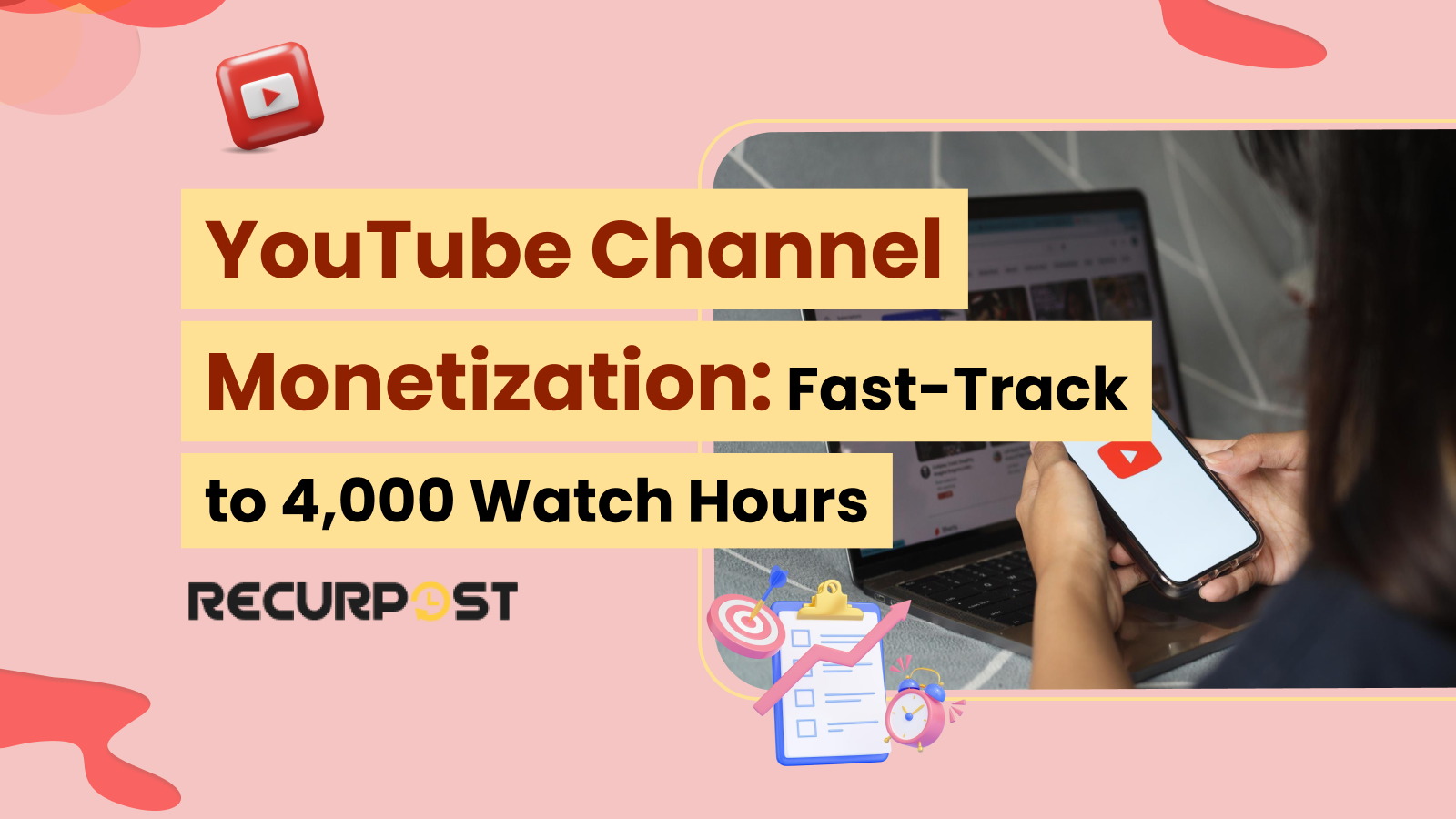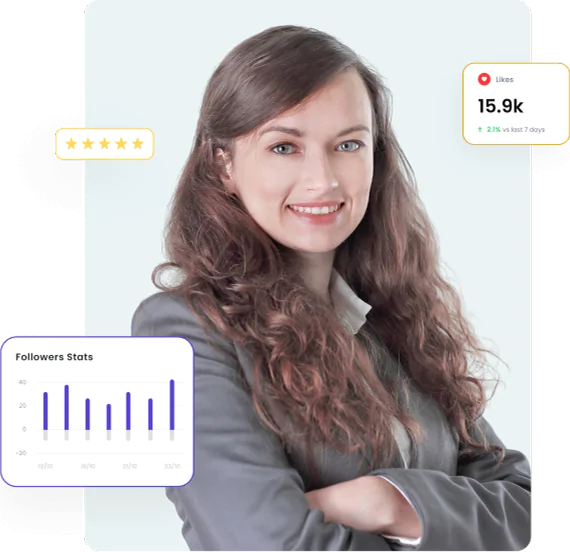Did you know just 3% of YouTube channels meet the YouTube monetization requirements? Out of 100 channels, only 3 reach the 4,000 watch hours and 1,000 subscribers needed to start earning through the YouTube Partner Program.
Don’t let that stop you. With a solid plan, you can monetize your YouTube channel for free and join the growing crowd of creators making money on YouTube.
Focusing on watch time the smart way can triple your odds of hitting monetization eligibility criteria within your first year. Success comes from knowing how the YouTube system works and staying consistent.
This guide walks you through meeting YouTube monetization requirements: from checking your channel monetization status to estimating earnings with a YouTube money calculator. You’ll learn about watch hours, subscriber targets, policies, and the steps to monitor progress, increase views, and dodge monetization setbacks.
The low 3% YouTube monetization rate reflects that many channels lack consistent posting schedules, proper content strategy, or long-term commitment. Channels that post regularly and follow proven growth strategies have significantly higher success rates. The creators who do reach YouTube monetization often share common traits: they post consistently, engage with their audience, and create content that solves specific problems or entertains their target viewers.
Understanding YouTube Watch Hours
What Are Watch Hours?
Watch hours show how long viewers spend watching your YouTube videos. One hour equals 60 minutes of watch time across your channel. For instance, if six people watch a 10-minute video in full, it adds up to one watch hour. YouTube monetization relies on this metric to reflect real engagement and give creators clear progress data.
Each of them contributes 10 minutes of watch time:
- 6 viewers × 10 minutes = 60 minutes
- 60 minutes = 1 watch hour
Why Watch Hours Matter for YouTube Monetization?
Watch hours qualify you for the YouTube Partner Program (YPP). These metrics: watch hours and subscriber count, reflect audience interest and determine your monetization eligibility status.
Watch time acts as a quality signal. High viewer retention means your videos hold attention longer, making YouTube more likely to recommend them.
YouTube’s algorithm favors engagement, not just clicks. Content that keeps viewers watching boosts your chances of meeting the YouTube monetization requirements.
How YouTube Calculates Watch Time
Here’s what counts toward your 4,000 watch hours target:
- Only public videos contribute – private or unlisted videos won’t help you reach YouTube monetization.
- Shorts views from the Shorts shelf don’t count toward the traditional watch hours requirement.
- Ad time, end screens, and description reading time don’t count.
- Views from properly embedded videos do count toward your total.
- YouTube tracks watch hours over a rolling 12-month period, based on the past 365 days of activity.
YouTube Monetization Requirements 2025
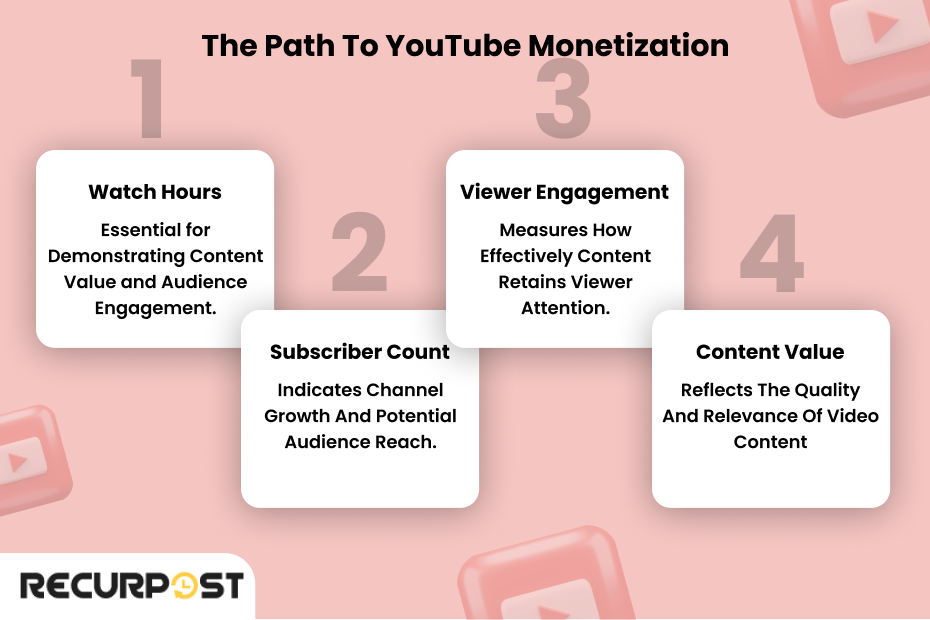
1. The 4,000 Watch Hours Threshold and YouTube monetization rates
The YouTube Partner Program requires 4,000 watch hours within a 12-month evaluation period, showing consistent viewer engagement.
For 2025, YouTube monetization requirements offer another path via Shorts. Channels can qualify with 10 million Shorts views in 90 days, reflecting the rise of short-form content. (PPC Land)
Private, unlisted, or deleted videos don’t count toward watch hours. Only Shorts views from the Shorts shelf apply to the 10 million goal.
2. The 1,000 Subscribers Requirement
Full channel monetization requires 1,000 subscribers. YouTube’s two-tier system allows earlier earnings:
Early Access Tier (500 subscribers):
Need 3 public uploads in 90 days
Access to Super Thanks, Super Chat, and shopping tools
Full Monetization Tier (1,000 subscribers):
Need 4,000 watch hours OR 10 million Shorts views
Unlocks all features, including AdSense and Channel Memberships
3. Additional Eligibility Criteria
Beyond watch hours and subscribers, you’ll need to meet a few more requirements to join YouTube’s Partner Program:
Follow YouTube monetization rules and guidelines: Your content needs to stick to YouTube’s Community Guidelines, Terms of Service, and copyright rules. Breaking these can get you strikes, which might delay or block your YouTube monetization journey.
Enable two-step verification: You’ll need this security feature to protect your account and ensure you’re the only one accessing your earnings.
Having no active Community Guidelines strikes: Any active strikes will put your Partner Program application on hold until they expire.
Live in an eligible country or region: Not every location has access to the Partner Program, so check if yours qualifies.
Have an active AdSense account: Link this to your YouTube channel – it’s where you’ll get paid.
Once you meet these monetization eligibility requirements, you can apply. YouTube reviews applications manually, which usually takes about a month.
How to Increase Your YouTube Watch Hours (Fast)
A. Make Longer, High-Retention Content
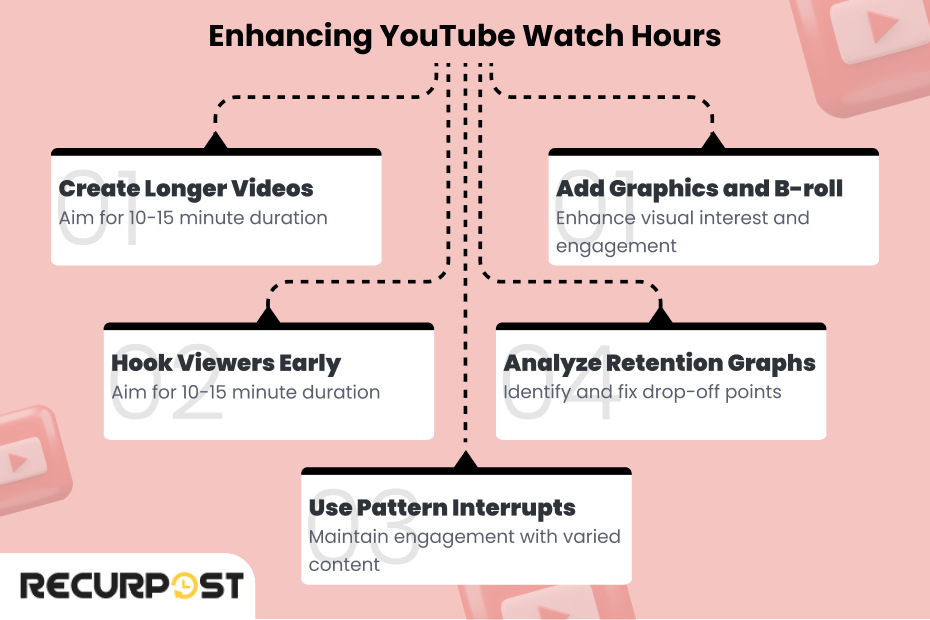
Longer YouTube videos that keep viewers engaged can quickly grow your watch hours. Educational content often earns 15.2% more views, making it ideal for increasing average view duration (AVD).
Videos lasting 10–15 minutes hit the sweet spot for audience retention. Length matters less than whether viewers stay until the end.
Your first 15 seconds are key – 20% of viewers leave fast. Start with a value or a strong hook to boost retention metrics.
Avoid long intros and early subscribe requests. Deliver value first, then prompt actions once you’ve earned trust.
Use pattern interrupts every 30–60 seconds: switch angles, shift energy, show B-roll, or ask thought-provoking questions.
Use YouTube Studio analytics to spot where viewers exit. Improve weak spots based on your audience retention data.
Break up talking-head videos with graphics, B-roll, or simple text overlays to boost visual appeal and watch time.
Higher average view duration tells YouTube’s algorithm your content is engaging, increasing the chances of getting recommended video placement.
B. Leveraging Playlists and Series
YouTube playlists can boost views by 50% through binge-watching. They improve search visibility and strengthen relationships between related videos, enhancing watch time. (Hootsuite)
To optimize your YouTube playlists:
1. Structure your videos in a logical sequence, whether by difficulty, timeline, or topic development.
2. Use end screens to promote your playlists instead of single videos to encourage longer viewing sessions.
3. A strong channel video and a professional banner can also make a huge difference in attracting new viewers. Make your playlist’s first video captivating – it’s your gateway to keeping viewers watching the series.
4. Build niche-specific playlists to serve different segments of your target audience.
5. Refresh playlists regularly with new content to maintain relevance and support your YouTube SEO.
Content series that build upon each other naturally increase views, grow subscriber count, and generate excitement for your next YouTube video.
C. Promoting Videos Across Platforms
Sharing your YouTube videos outside the platform helps increase watch hours. Embedded videos on websites also count toward your total and drive fresh traffic.
Platforms like Quora attract engaged viewers when you answer niche questions and include related video links.
Even a small email list can generate quality views when you consistently promote your YouTube content.
Adapt your YouTube promotion strategy to each platform:
- Design Pinterest thumbnails that catch attention instantly.
- Engage authentically on Reddit before sharing links.
- Post professional-style YouTube content on LinkedIn.
- Make teaser clips for Instagram Reels and TikTok to attract interest.
Avoid spamming Facebook groups – it’ll hurt your reach. Instead, add value to discussions before sharing content. Tag relevant people authentically when appropriate, like brands or experts you’ve featured.
Real-World Success Stories (with data)
1. Case Studies of Channels That Reached YouTube Monetization
Let’s explore some success stories:
- Creator Bryan Guerra monetized four faceless channels in 16 months through niche selection and AI-powered content creation, reaching 4,000 watch hours per channel in about 4 months. His methods combined a Volume Approach testing niches with AI-generated videos and a Quality-Focused Approach using AI scripts with professional voiceovers, posting consistently three times weekly using a YouTube Scheduler.
Age doesn’t limit success on YouTube. Take Ketogenic Woman and Busbee Style – they’ve built huge audiences serving specific demographics.
- Ketogenic Woman: Anita monetized her YouTube channel in 8 months by sharing keto and carnivore diet tips for women over 50, focusing on recipes, meal plans, and real-life experiences.
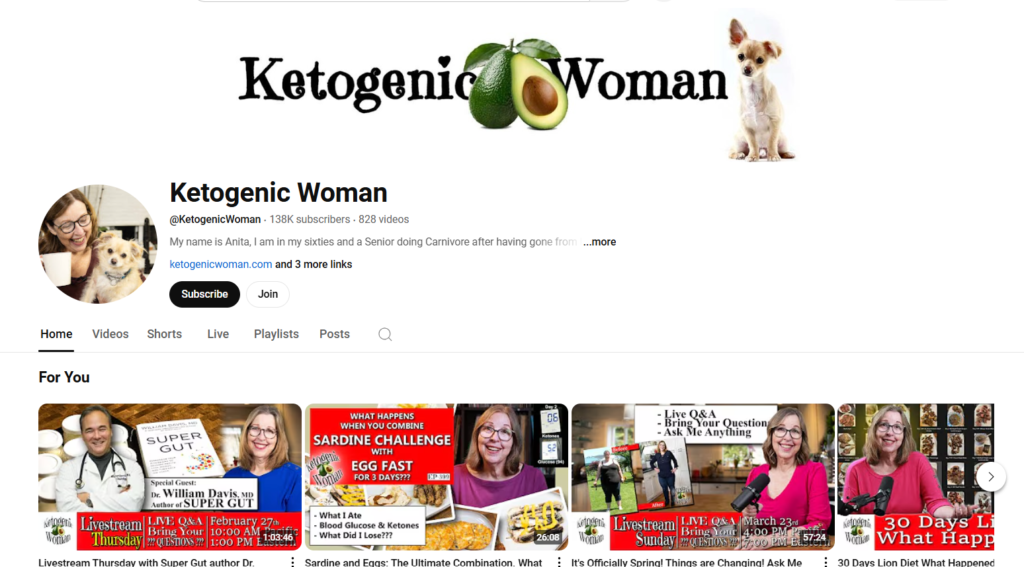
- Busbee Style: Erin Busbee grew her channel to 100,000+ subscribers by offering fashion advice for women over 40, simplifying style with wardrobe essentials and trend updates.
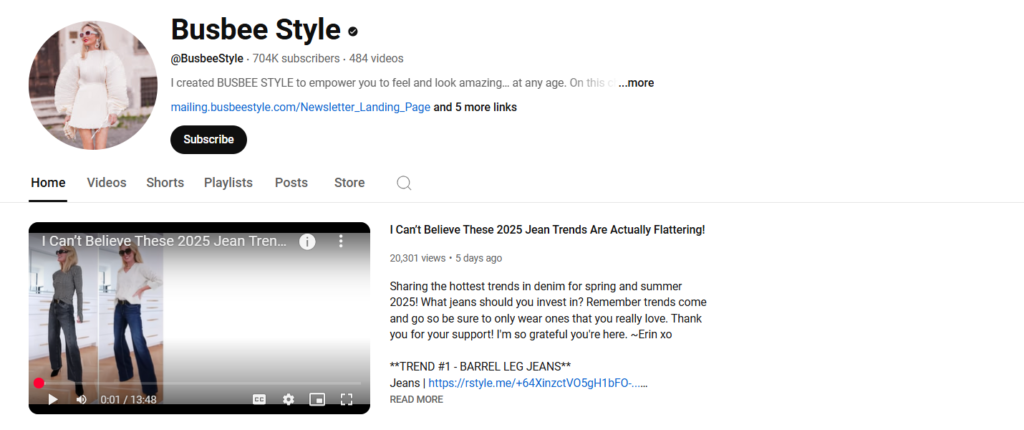
2. Timeline Analysis of Successful Creators
Niche YouTube channels often reach YouTube monetization within 8–12 months. Broader topics may take 12–18 months. One finance channel doubled from 50K to 112K subscribers in a year by focusing on targeted investment content.
Early creators like Michael Buckley (“What the Buck?”) show the power of consistency. Most successful channels double watch hours and subscriber count each year. Starting at 100 monthly watch hours? You could hit 200 in 6–12 months with regular uploads.
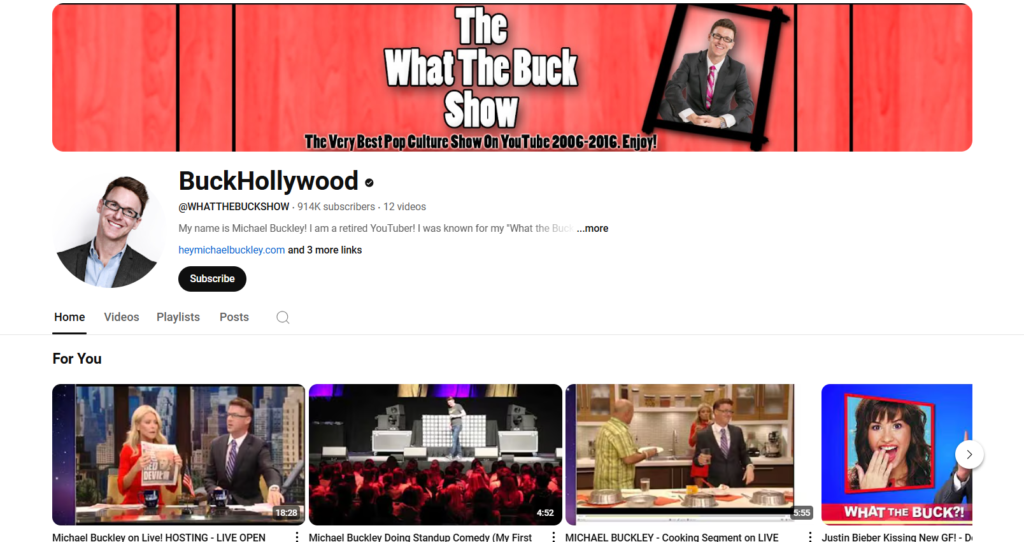
3. Lessons from Top Performers
Top YouTubers like Mr. Beast show that quality exceeds quantity. He invests weeks or months perfecting individual videos, outperforming rushed daily content.
Narrow content beats general topics. Focusing on niche YouTube content builds authority, helps you rank, and attracts loyal subscribers faster.
Build a YouTube community by replying to comments and making Q&A videos. Engagement increases when creators connect authentically with viewers.
Smart creators track YouTube analytics to improve content. Study which videos keep viewers engaged and where drop-offs occur to optimize your strategy.
Mistakes That Crush Watch Time
1. Content That Hurts Watch Time
Poor audio turns viewers off faster than bad video. Adjusting volume annoys users, hurting audience retention. Use quality mics and learn basic audio editing to improve your YouTube content.
Thumbnails matter. Keep them clean, bold, and emotional. Avoid clutter or heavy text. Eye-catching YouTube thumbnails boost click-through rate.
Watch out for these time-wasting intro mistakes:
- Starting with channel intros before hooks
- Asking for subscriptions too early
- Revealing key information right away instead of throughout your video
Your first 15–30 seconds decide whether someone stays. Open strong to improve viewer retention and watch time.
2. Algorithm Mistakes
Sharing videos on Facebook or Twitter results in views through native players that don’t count toward YouTube watch time. Focus promotion on platforms directing traffic to YouTube, such as Reddit, Quora, or email newsletters with direct links.
Avoid buying YouTube subscribers. Fake followers hurt your watch time metrics and reduce audience retention. YouTube detects this mismatch fast. Grow your YouTube audience organically for long-term results.
Clickbait may get clicks, but it harms viewer retention and trust. Misleading titles or YouTube thumbnails lead to early exits, signaling to YouTube that your content quality is poor.
3. Growth Plateaus and How to Overcome Them
Growth plateaus occur in every YouTube channel’s journey, but aren’t permanent. These plateaus affect even successful creators and commonly result from:
- Repeating similar YouTube videos without improving the content strategy
- Lacking systems for scaling YouTube content and tracking metrics
Tracking and Analyzing Your Watch Hours
Where to Check Watch Hours?
Track watch hours regularly to monitor YouTube monetization progress. Check YouTube channel metrics in YouTube Studio:
Go to YouTube Studio, where the monetization YouTube Studio dashboard provides all the metrics you need. While third-party tools like a YouTube money calculator can be interesting, the most accurate data comes directly from YouTube.
Click on Analytics. Within the Analytics section, click on the “Advanced Mode” option to view detailed data.
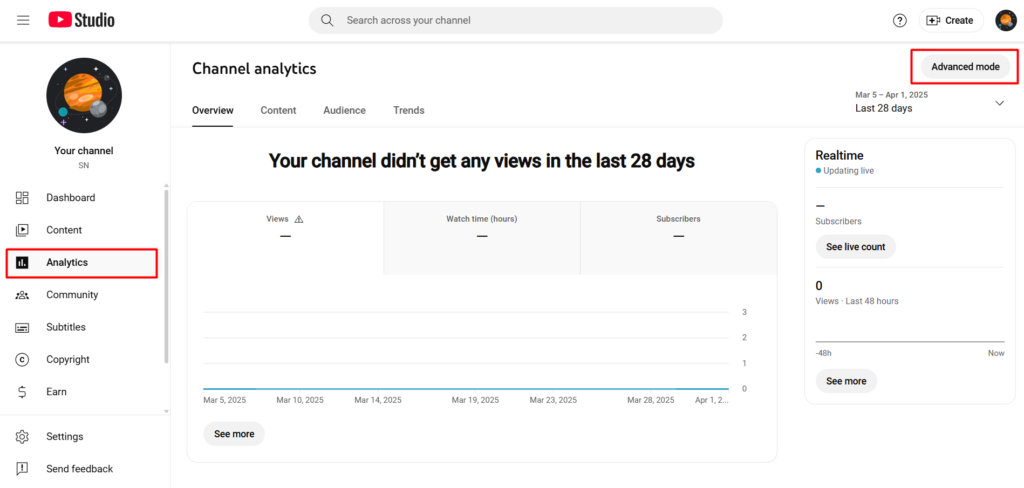
Navigate to the Earn tab.
Now, scroll down and look under How do I join? > Watch Time to see your total hours.
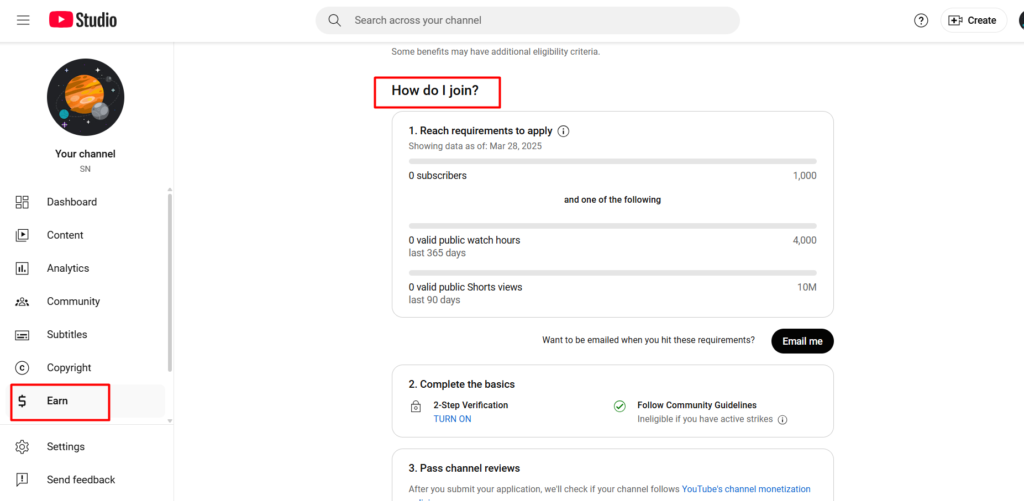
Make sure you’re looking at data for the last 365 days, as YouTube only counts watch hours from the past year. Also, note that Shorts watch time does not count toward YouTube monetization eligibility, so focus on regular videos and live streams.
Key Metrics Beyond Watch Time
Beyond watch hours, these analytics measure content performance:
- Audience Retention: Aim for 50%+ retention to keep viewers engaged.
- Click-Through Rate (CTR): A 4%+ CTR means your thumbnails and titles are effective.
- Traffic Sources: Understand where your viewers come from (Search, Suggested Videos, External).
- Returning vs. New Viewers: Growing your community means balancing new viewers with returning fans.
To dive deeper, use Advanced Mode in YouTube Analytics:
Click See More.
Select Advanced Mode.
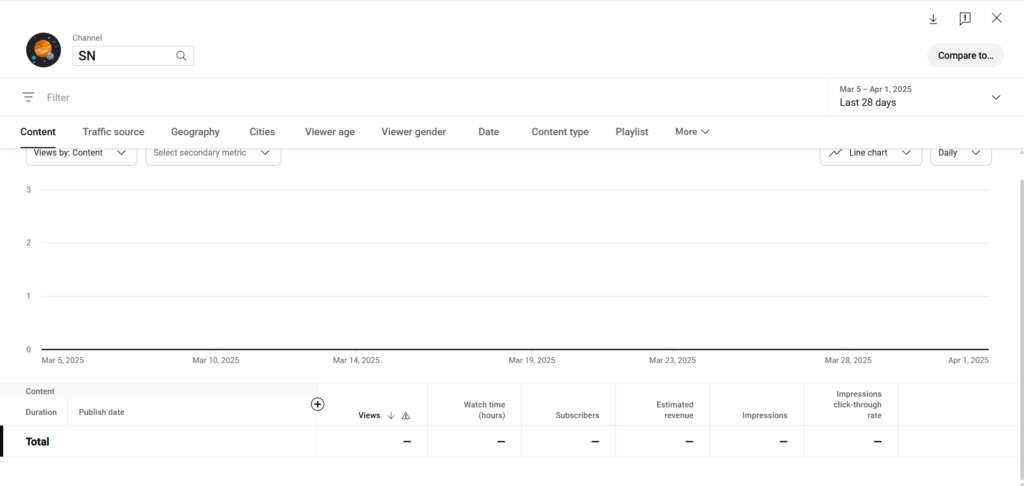
Analyze trends for watch time, CTR, and audience retention.
Setting Realistic Milestones
YouTube channel growth follows patterns rather than linear progression. Set percentage-based growth goals:
- Increasing watch hours by 10-15% per month.
- Growing subscribers by 5-10% each week.
Expect growth plateaus, but stay consistent. Many channels experience hockey stick growth, where progress is slow at first but skyrockets after hitting a tipping point. YouTube Monetization typically takes 6-12 months of consistent effort, so stay patient!
YouTube Monetization Beyond AdSense
1. Alternative Revenue Sources
YouTube offers diverse monetization options beyond AdSense to boost income and engagement:
- Channel Memberships: Offer exclusive badges, emojis, and videos to paying subscribers.
- Super Chat & Super Stickers: Fans can donate during live streams.
- Merchandise Sales: Use print-on-demand tools and tag products in your YouTube videos
These features increase creator income while strengthening your YouTube community.
2. Maximizing Earnings After Reaching Requirements
Once you hit 1,000 subscribers and 4,000 watch hours, grow revenue with:
- Making advertiser-friendly content to attract premium ads
- Earning from YouTube Premium based on watch time
- Licensing your videos for platforms like TV or streaming media
- Using YouTube Shopping tools to showcase your merchandise
- Repurposing videos as podcasts or audio for extra exposure
3. Diversify Your Creator Income
Go beyond AdSense revenue with multiple YouTube monetization strategies:
Brand Partnerships:
- 50-100K subscribers: $500-$1,000 per sponsored video.
- 500K+ subscribers: $3,000-$5,000+ per video.
Affiliate Marketing: Promote products through Amazon, ShareASale, or niche-specific programs.
Crowdfunding Platforms: Offer exclusive perks via Patreon, Buy Me a Coffee, or Ko-fi.
Sell Digital Products: An email list + digital products (courses, templates) can be a high-margin strategy.
[Learn more: How to go viral on YouTube Shorts and How to promote YouTube videos on YouTube]
Conclusion
Hitting YouTube monetization thresholds marks the start of your creator journey. Strategically increasing YouTube watch hours, optimizing watch time video metadata, and using smart monetization strategies leads to steady income beyond AdSense revenue.
Whether you’re growing with long-form content, improving audience retention, or landing brand deals, patience and consistency drive growth. Successful creators don’t chase views – they build loyal, engaged YouTube communities.
Want to monetize copyrighted music? Explore YouTube’s Content ID and music licensing programs.
You’ve taken the first step. Now activate YouTube monetization, monitor your channel growth, and build your revenue-generating machine!
FAQs About YouTube Monetization
1. What counts as valid watch hours toward YouTube monetization?
Only public long-form videos count toward the 4,000 watch hours needed for YouTube monetization. Private videos, unlisted videos, and YouTube live streams and shorts don’t contribute to this requirement. Keep creating engaging content to boost your YouTube statistics!
2. If I meet the threshold requirements, am I automatically monetized?
Not instantly. YouTube reviews your channel to verify you meet all YouTube monetization policies. They check content quality, copyright compliance, and community guidelines.
3. What happens if my metrics drop below the threshold after applying?
No worries! If your numbers dip during the review, YouTube still processes your application. Just make sure you’ve completed all YPP signup steps. This is key to getting approved.
4. Why was my YouTube monetization application rejected?
Common reasons include policy violations, reused content, or copyright issues. You can check YouTube’s feedback, fix any issues, and reapply in 30 days to improve your chances of approval. A solid marketing strategy for YouTube helps keep your content in good standing!
5. Can I monetize with fewer than 1,000 subscribers?
Yes! At 500 subscribers, you can access features like Super Thanks, Super Chats, and Channel Memberships, but you won’t have full ad monetization until you reach 1,000 subscribers. Keep pushing to promote video on YouTube and grow your audience!
6. What happens if my channel becomes inactive?
If you don’t upload or post for six months, YouTube can remove your monetization privileges. Stay active with regular uploads and community posts to keep your YouTube analytics strong and your revenue flowing through YouTube ads!
7. How to check YouTube monetization on a phone?
Use the YouTube Studio app to monitor YouTube monetization on your phone. Tap the Earn tab to see real-time watch hours and subscriber count.

Shalini Nagar is an experienced content writer with a proven track record of creating diverse and engaging content across various formats. With years of expertise in crafting blogs, articles, she excels at delivering compelling narratives tailored to different audiences.

